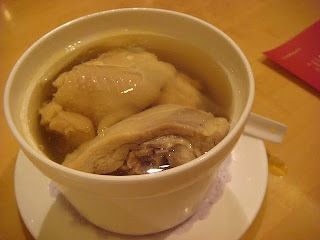I don't know when I'll be able to travel to Tibet, so I decided that I'll just have to make do with lunching at one the oldest Tibetan restaurants in Beijing, even if it is a chain (2 in Beijing, 1 in Kunming, and 1 in Lhasa).
Unclear store front and sketchy, dark staircase
If you're ever interested in trying Makye Ame in Beijing, you'll need to know a few things.
First of all, bring lots of money because it's relatively expensive compared to other dining establishments around the city. I think it's because some of the ingredients are native to the Tibetan Plateau.
Secondly, don't freak out about the creepy staircase leading up the door; it's absolutely gorgeous inside!
Interior of Makye Ame
Fresh Pear and Apple Juice; Some kind of Tibetan Tea
I heard about the tasty but rare songrong mushrooms from Yunnan province while researching Beijing restaurants on the internet, and I didn't really think that I would encounter them at any of the restaurants I picked since Yunnan cuisine was not on my list. I think songrong mushrooms are the same as matsutake. This dish alone is 128 RMB (around $21). That's an astounding price for mushrooms. However, I felt that I wouldn't get a chance to try these any time soon, so why not eat a couple more homecooked meals in China to compensate for this splurge?
Songrong Mushrooms and Onions Cooked on Hot Rock
Songrong Mushrooms and Onions Cooked on Hot Rock
The songrong mushrooms were musty, rich, and buttery. But if you're not a mushroom fan, you may feel that they're not $21 bucks - good.
We were all really hungry, at least that was our excuse for ordering 2 meat dishes: Yak and Lamb Ribs.
Both had a tasty exterior, which was very appealing, but a bit too dry on the inside. The lamb ribs were very fatty. The yak meat was actually our favorite of the two because it was meatier, and tasted a lot like beef. No wonder the Chinese name for "yak" is just "hairy cow."
Tibetan Crisp Yak "Steak"...but looked like Ribs
Roasted Lamb Ribs
We ordered the Highland Barley dish because we wanted to be able to say that we've eaten something that's cooked in yak butter. Well, yak butter tastes like butter. No surprises there! But the slightly sweetened barley was especially delicious with the goji berries and weird red-brown root-like stubbs. S. and I didn't say anything at first because we both thought that it was dongchongxiacao (winter worm - summer herb), also known as cordyceps, a parisitic fungus. We didn't want to scare B., who was also enjoying the oddly shaped maroon things in the barley. S. and I were arguing about whether these things were actually cordyceps until the waitress finally put our question to rest. They were a kind of Tibetan ginseng root.
Highland Barley Grains Fried with Yak Butter
I can neither recommend nor advise against eating at Makye Ame. It was the first time I had Tibetan food, and it satisified some of culinary curiousity, but I couldn't help but think that this isn't completely representative of Tibetan cuisine. The restaurant was too clean, too comfortable, and too aware of being "Tibetan." I couldn't help but think that the food I ate was a sterilized version of the cuisine. I need to go to Tibet before I can pass any judgment on the food at Makye Ame.







































